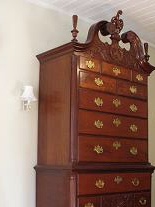Moulding on convex or concave curved piece of wood
Welcome! / Forums / General Woodworking Discussions / Woodworking Methods and Techniques / Moulding on convex or concave curved piece of wood
- This topic has 14 replies, 6 voices, and was last updated 4 years, 8 months ago by
Benoît Van Noten.
-
AuthorPosts
-
22 August 2019 at 5:59 pm #601756
Hi all,
Does anyone have an idea how this moulding on a curved piece of wood has been made, or something like that could be made?
Is there some type of special moulding plane or moulding scraper that could create this shape?
Or was this ‘simply’ chiseled out?This cabinet has been made by hand entirely, so I don’t think any machine was involved…
Appreciate any thoughts!
Thanks!
Attachments:
You must be logged in to view attached files.ehisey could be right that this was done with a scratch stock. They scratch away wood like scrapers. They are sold by Lie Nielsen and Veritas, and I am pretty sure at least one of them comes with a fence for curved shapes like in your picture. But those scratch stocks seem mainly designed for smaller beading and fluting and such. At least the cutters that come with their scratch stocks are designed for those limited purposes. You can make your own cutters of course, or, for that matter, you can make your own scratch stock from scratch, so to speak. Those can be bigger, as big as you want. There are plenty of directions for making scratch stocks on line. They are easy to make, and even the cutters are easy if you have a bit of spring steel. On the other hand, I wonder whether much of the shaping on your piece was carved withe various carving chisels. Obviously the central design was carved. Is there any reason why the rest couldn’t have been carved?
23 August 2019 at 9:10 am #601933I’ll disagree.
That looks like a fairly modern piece and not very complicated, so I’ll bet the tool used was a moulding cutter/ spindle shaper, depending which side of the pond you are on.
Watch this video. At the end there will be a quiz on all the OSHA rules that were broken.
I have blood curdling stories regarding that tool.
-
This reply was modified 4 years, 8 months ago by
Larry Geib.
Larry is right, of course, that machines can make things like this. In fact, in the next video my youtube brings up after the one Larry posted, Mat Cremona has a vid making a Goose Neck moulding for a fancy secretary desk using a normal hand router and a bunch of jigs. https://www.youtube.com/watch?v=v0hNKt6kByc. Besides being pretty fascinating, his vid (and many others) show how much skill goes into machine work once you get past the basics. On the other hand, we do know these shapes were made in large numbers long before there were spindle moulders and routers. I wonder how? I do not know how old Wim’s piece is, but no doubt it too could be made by hand. I have a few old moulding planes, and they are only good for straight mouldings. Were there similar moulding planes dedicated to curved moulding? If so I have not noticed them on ebay or elsewhere.
23 August 2019 at 5:50 pm #602026Well, in the old days, they went at it with gouges and scrapers. Labor was cheap.
I worked in a shop that did reproduction work and that’s how they did it. I doubt huge numbers were ever made. These were pieces for the elites. Most people never even saw something like these.It was the Victorian era that saw the proliferation of this kind of work as part of the industrial revolution. The first heavy duty line shaft/belt powered spindle Moulder appeared around 1870. Before that, small pedal powered units were available before the civil war in this country. The Barnes model below first appeared in a catalogue in 1877.
There were curved moulding planes, mostly in the carriage maker’s trade, but I don’t think they produced many arch tops.
-
This reply was modified 4 years, 8 months ago by
Larry Geib.
Attachments:
You must be logged in to view attached files. 23 August 2019 at 9:04 pm #602078
23 August 2019 at 9:04 pm #602078Roubo describes in his book “With All Precision Possible” (Lost Art Press), the use of various gouges and very short curved moulding planes. The latter apparently gave a smoother result.
Interesting, and thanks Sven-Olog for the reference to Roubo’s book “With all Precision Possible.” I guess I have to get yet another book from Lost Art Press!! So how do hand tool woodworkers make something like this today? I have not seen any short curved moulding planes such as those mentioned by Sven-Olof. Gouges and scrapers as mentioned by Larry? I know power tool folk do make this sort of thing with routers and such. I assume hand tool folk do as well now a days. I probably have something about this is one of the wood working books on my selves, but nothing comes immediately to mind. If I were to try something like this (who knows?) I would probably experiment with gauges and scrapers. To take a phrase from Larry, my labor is cheap!
26 August 2019 at 6:32 am #602787Mary May has several posts on her carving the top of a seventeenth century Philadelphia Highboy. ( FIVE of them, in fact)

There is very little of that piece that could have been made with even the shortest of moulding planes.
As to Roubo mentioning short planes for curved work, I suspect he was talking about a larger scale. There aren’t any planes I see in his Book Of plates that would have been adaptable to house size pieces that I see.
Even with a set of thes coach maker’s planes, there is maybe only 18” total of the top of that piece that could have been done without hand carving it.
A moulding like that in the original post probably could be done with extensive use of carriage makers planes, however.

-
This reply was modified 4 years, 8 months ago by
Larry Geib.
26 August 2019 at 5:03 pm #602918Nice video here:
curved molding shown starting at about 37′ but explanation is before.27 August 2019 at 3:57 am #603086Great video. I loved the ¡aha! Moments. Wish I had gotten more than 5% of what they were saying.
 27 August 2019 at 10:48 am #603138
27 August 2019 at 10:48 am #603138While a presentation in English would be asking for too much, one could – as this was an academic work from two universities – perhaps have hoped for subtitles. International sharing of research is after all a core part of academia.
There are actually some other quite interesting publications that really should have been in English.
27 August 2019 at 12:03 pm #603148I wish I could understand Nordic languages.
here is an interesting study with an English version:
https://gupea.ub.gu.se/handle/2077/35598 27 August 2019 at 7:57 pm #603276
27 August 2019 at 7:57 pm #603276And a lot more interesting than most theses I have had to take oart of.
Here’s a link to a BA paper on the qualified art of making Ålandish windows (Åland: an archipelago in the Baltic Sea). Sadly, it’s in Swedish, but the photos and drawings should hopefully be of some interest
https://gupea.ub.gu.se/handle/2077/27834
28 August 2019 at 8:29 am #603415Sven-Olof
I have once seen a video about sash windows where they were using the same profile but only at right angle.
Very interesting.
If needed we can cut and paste in a translator but the drawings and picture are nearly self explanatory.
Unfortunately translators are not perfect and the result must be interpreted. -
This reply was modified 4 years, 8 months ago by
-
AuthorPosts
- You must be logged in to reply to this topic.
